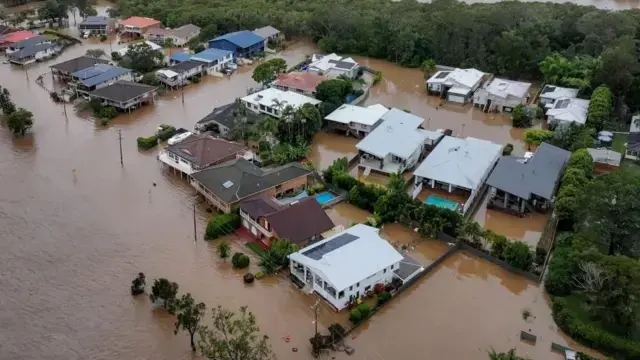The catastrophic Australia flooding across New South Wales has claimed lives and left countless individuals isolated, marking one of the region’s most severe natural disasters in recent memory. Record rainfall has inundated areas spanning from Sydney to Newcastle and the Mid North Coast, prompting emergency declarations and widespread evacuations. As rescue efforts intensify, authorities, led by Prime Minister Anthony Albanese and NSW Premier Chris Minns, are grappling with the immense scale of the crisis.
“It’s very difficult to get supplies into some of these isolated communities,” Premier Minns stated, underscoring the logistical challenges responders face.
The relentless deluge has left a trail of devastation, with entire communities submerged and critical infrastructure crippled. The New South Wales region is bearing the brunt of the Australia flooding.
The Devastating Impact of the NSW Floods
The floods have resulted in confirmed fatalities, each death a tragic consequence of the unprecedented weather event. Details emerging from police reports paint a grim picture of individuals caught in the unforgiving currents. Search operations are ongoing for those still missing, their last known locations now submerged beneath floodwaters. The scale of the Australia flooding in New South Wales is becoming more clear as each day passes.
“Devastating,” Prime Minister Albanese posted on X, conveying the nation’s grief and solidarity with the affected communities.
Approximately 50,000 people find themselves isolated, cut off from essential services and support networks. Schools have been forced to close, transforming into temporary evacuation centers for those displaced from their homes. On the Mid North Coast alone, nearly 10,000 homes are at risk of flooding, a stark reminder of the sheer magnitude of the disaster.
Record Rainfall and Weather Conditions
The catalyst for this catastrophe lies in a slow-moving area of low pressure that has unleashed record rainfall across the region. For many residents, the intensity of the downpour surpasses anything they have witnessed in their lifetimes, local authorities have confirmed. The Taree river, for example, has surged past a century-old record, a testament to the extreme weather conditions.
The Bureau of Meteorology has issued numerous weather warnings for southern parts of the state, including Sydney and Newcastle, urging residents to remain vigilant. Over 150 flood warnings are currently in place, with 40 classified as emergency level, highlighting the imminent threat to life and property.
Emergency Response and Rescue Operations
The NSW State Emergency Service (SES) has been at the forefront of rescue operations, performing more than 535 flood rescues in a single 24-hour period. Despite their tireless efforts, authorities continue to emphasize the critical importance of avoiding driving or entering floodwaters. Every submersion can put citizens in danger. The Australia flooding is no joke.
“Throw every single thing we’ve got,” said Jihad Dib, NSW Minister for Emergency Services, underscoring the government’s unwavering commitment to rescue operations.
Prime Minister Albanese is scheduled to visit flood-affected areas alongside Premier Chris Minns, a demonstration of the federal government’s support for the state. Premier Minns has cautioned that the state is “far from out of the woods,” a sobering reminder of the challenges that lie ahead. The Prime Minister has pledged the full support of the federal government, while Premier Minns has urged residents in “prepare to evacuate” areas to leave if possible.
Challenges and Future Concerns
Logistical difficulties are hampering efforts to deliver essential supplies to isolated communities, Premier Minns has acknowledged. The floodwaters have rendered many roads impassable, making it challenging to reach those in need.
“It’s very difficult to get supplies into some of these isolated communities,” Premier Minns stated.
“We are bracing for more bad news,” Premier Minns has warned, highlighting the potential for further deterioration of the situation. The long-term implications of the flooding are immense, with widespread damage to homes, businesses, and infrastructure.
The recovery period will undoubtedly be protracted and demanding.
Conclusion
The Australia flooding crisis in New South Wales represents an unprecedented natural disaster, characterized by tragic loss of life, widespread inundation, and ongoing rescue efforts. The record rainfall has overwhelmed communities and infrastructure, posing immense challenges to authorities and residents alike. As the crisis unfolds, it is crucial to stay informed about the latest updates and support relief efforts. If possible, consider donating to registered charities providing assistance to those affected or volunteer your time to help with cleanup efforts.
Additionally, homeowners in flood-prone areas should take proactive steps to protect their properties by elevating appliances, clearing gutters and downspouts, and creating an emergency plan. Staying informed and prepared is crucial for mitigating the impact of future flooding events.
Image Source: MYJOYONLINE






















